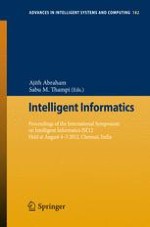This book constitutes the thoroughly refereed post-conference proceedings of the first International Symposium on Intelligent Informatics (ISI'12) held in Chennai, India during August 4-5, 2012. The 54 revised papers presented were carefully reviewed and selected from 165 initial submissions. The papers are organized in topical sections on data mining, clustering and intelligent information systems, multi agent systems, pattern recognition, signal and image processing and, computer networks and distributed systems. The book is directed to the researchers and scientists engaged in various fields of intelligent informatics.
